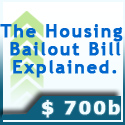7 Housing Trends to Look for Going into 2013. Did the foreclosure pipeline increase last month?
There was an interesting trend that emerged last month. 2012 has seen a reversal in the housing market yet this topic has been largely absent from all debates. The piece of data that was released addressed the still formidable foreclosure pipeline. Foreclosure starts saw a 260,000 increase from the previous month. It is expected that actual foreclosures are decreasing as the pipeline is being sold and as the economy recovers, this figure will slowly move down. Yet to see the foreclosure starts pipeline increase goes counter to everything we are hearing. What gives? There are a few reasons for this increase. We also need to explore the building side of the equation and how rents have been picking up in 2012. The flood of investors and Wall Street swarming into the rental market is a new experience. What are the trends for housing going into 2013?
Posted in: banking,debt,foreclosures,housing-data,market analysis,real-estate
China’s real estate bubble overflowing into targeted US cities – Hong Kong imposes 15 percent tax on property purchases made by foreigners. The push for housing near quality universities.
The amount of money flowing in from global markets is incredibly strong. To be more specific buyers from China are big players in many prime areas especially in California. Access to high quality universities and prime neighborhoods is simply another factor that will keep prices inflated more than people may think. Canadians have firsthand experience in this global real estate market push. If you think our real estate bubble was amazing you simply have no idea what is going on in China at the current moment. This past weekend, the Hong Kong government put on a 15 percent tax on property purchases made by foreigners. There is no question that the market is overheating and the government is readily admitting it and even going to these extremes. Put this into perspective with US real estate in 2007 when the Fed was still reticent to admit that we were experiencing a heated real estate market. At this point it is too late and places where this hot money is flowing like a few Canadian cities will feel a pull back once the current trend stalls or even reverses.
Posted in: California Love,california-equity-giants,china real estate,real-estate
How to increase home prices in the face of stagnant household incomes – 6 charts exploring the state of the US and California housing market. 9 million homeowners are still underwater. Pockets of real estate mania.
It is easy to get swept into the momentum of the housing market. The Federal Reserve has managed to push interest rates to historically low levels creating additional buying power for US households. As we enter the slower fall and winter selling season, there is unlikely to be any major changes until 2013 as the election year concludes. We do face major challenges ahead. This current momentum in housing isn’t being caused by flush state budgets or solid wage growth. No, this is being caused by low inventory, big investors crowding out households, and a concerted effort to push mortgage rates lower. If you simply follow the herd, you would think that prices are now near peak levels again (or soon will be) and household incomes are hitting record levels. Let us examine where things stand today deep in 2012.
Posted in: bailout,california-equity-giants,foreclosures,housing-data,market analysis,southern-california-housing
Exploring the rich foreclosure pipeline of Beverly Hills – 2 Foreclosures versus 86 in the distressed pipeline. New data features allow public to search for distressed properties.
I have been crunching the numbers on the housing market and the more fascinating trend isn’t what is happening with home prices but the actual consumer behavior driving the change. When we started getting more access to information in the early 2000s I thought this would serve as a buffer in terms of capping future bubbles. Instead, it actually ramped up the mania. Information goes viral. So seeing prices go up actually caused people to buy basing their actions on recent trends and the information was available 24/7. Before easily accessible information you simply relied on local sales comps and the advice of your real estate agent. The newspaper analysis served as your bigger city snapshot. Today, most people can dig through the information and find tons of data. And this makes this boom-bust-boom cycle so fascinating. Some of you have noticed that Zillow now offers a snapshot of foreclosure data. For example, let us look at the always exclusive Beverly Hills.
Posted in: California Love,california-equity-giants,debt,housing-data,market analysis,Price Check,southern-california-housing
 Subscribe to feed
Subscribe to feed





Blogroll
- Bull! Not Bull!
- Calculated Risk
- Clive Maund
- Commonsense Forecaster
- Daneric's Elliott Waves
- *Dollar Collapse
- Economist's View
- FallStreet
- Fiend SuperBear
- Finance my Money
- Financial Sense
- Foreclosure.com
- Jesse's Cafe Americain
- Max Keiser
- My Budget 360
- Itulip.com
- Robb Wolf - Paleo The Mess That Greenspan Made
- The Burning Platform
- Of Two Minds
- SteveQuayle.com
- Survival Blog
- W.C. Varones Blog
- Zero Hedge
- Preppers : TheSurvivalistBlog.net
- Bay Area RE Trends
- Bubble Meter
- History of a Housing Bubble - LA Times Archive From Previous Housing Bubble
- Irvine Housing Blog
- Long Beach RE Blog
- OChousingnews
- Patrick.net
- Piggington's Econo-Almanac (San Diego Info)
- Sacramento Land(ing)
- WestsideREmeltdown
- Countrywide-Foreclosures Blog
- Great Depression of 2006
- House Bubble
- Housing Chronicles
- Housing Panic
- Housing Panic 2.0
- HousingTracker (Real Estate Market Stats)
- Housingwire
- *Mortgage Lender Implode-O-Meter
- Paper Economy
- Portland Housing Blog
- UK Housing Bubble
- Home Fish
- Foreclosures
- Daily Crash Report
- Loan Modification Ebook
-
Real Estate Cycles (1800 - 2005)

Life, Politics, Economics, and Wealth
California Real Estate
National Real Estate
Regional Housing Blogs
Other Housing Related Sites
Other Sites
Housing Data and Finance Blogs

